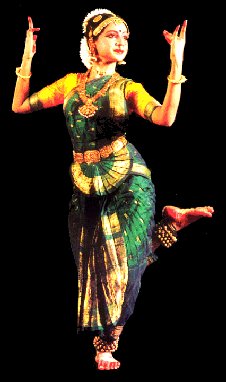Bharatnatyam
Bharat Natyam is one of the popular and exalted dance forms of India. Traditionally associated with Tamil Nadu, Bharatnatyam now commands as strong presence in India and worldwide.
History and Origin
The history of Bharat Natyam is interesting. The genre of Bharat Natyam was developed by amalgamating a number of elements from the earlier forms of Dassi Attam and Sadr. Dassi Attam was a dance form of the Deva Dassis (temple dancing girls) while Sadr was a form found in the palaces of southern India. A number of people contributed to the development of Bharat Natyam, but the most notable was E. Krishna Iyer of Madras (Chennai). This was in the 1930's
 It is difficult to determine the age of Bharat Natyam; this is due to the evolving nature of Indian dance. Although Bharat Natyam evolved from Sadr and Dassi Attam, there are differences. If one feels that Bharat Natyam is different enough to be considered a distinct genre, then we may safely say that it is only about 70 years old. On the other hand, if we consider the differences to be insignificant, then we may push the age back several hundred years. It was codified and documented as a performing art in the 19th century by four brothers known as the Tanjore Quartet whose musical compositions for dance form the bulk of the Bharata Natyam repertoire even today. The art was handed down as a living tradition from generation to generation under the Devadasi system under which women were dedicated to temples to serve the deity as dancers and musicians forming part of the elaborate rituals. These highly talented artists and the male gurus (nattuvanars) were the sole repository of the art until the early 20th century when a renewal of interest in India's cultural heritage prompted the educated elite to discover its beauty. However, the careless manner in which many artists date Bharat Natyam back to the Natya Shastra is absolutely preposterous. The cumulative changes that have occurred over the last 2000 years make such statements totally insupportable.
It is difficult to determine the age of Bharat Natyam; this is due to the evolving nature of Indian dance. Although Bharat Natyam evolved from Sadr and Dassi Attam, there are differences. If one feels that Bharat Natyam is different enough to be considered a distinct genre, then we may safely say that it is only about 70 years old. On the other hand, if we consider the differences to be insignificant, then we may push the age back several hundred years. It was codified and documented as a performing art in the 19th century by four brothers known as the Tanjore Quartet whose musical compositions for dance form the bulk of the Bharata Natyam repertoire even today. The art was handed down as a living tradition from generation to generation under the Devadasi system under which women were dedicated to temples to serve the deity as dancers and musicians forming part of the elaborate rituals. These highly talented artists and the male gurus (nattuvanars) were the sole repository of the art until the early 20th century when a renewal of interest in India's cultural heritage prompted the educated elite to discover its beauty. However, the careless manner in which many artists date Bharat Natyam back to the Natya Shastra is absolutely preposterous. The cumulative changes that have occurred over the last 2000 years make such statements totally insupportable.
Performance & Features
The complete performance of this dance involves six stage known as Alarippu, Jatiswaram, Sabdam, Varnam, Padam and Thillana. These stages combine the elements of Nritta or pure dance, and Nritya (expressive dance).Nritta comprises three elements, a basic standing position, movement of the legs and feet and also decorative hand gestures.Timing is based on beats of equal length known as Jatis.
Vocalist conduct the dance movements by calling out Shollukatus or rhythmic syllables.
There are a number of musicians and instrumentalists who provide the musical accompaniment. Typically there is one or more vocalist, a person reciting the dance syllables, and a mridangam. Additionally, one usually finds violin, vina (saraswati vina), or venu (bamboo flute). There is also a thallam (manjira) which is usually played by the person reciting the dance syllables. The overall style of the Bharat Natyam musical accompaniment is not unlike other Carnatic performances.
All of the traditional elements of classical dance are present in Bharat Natyam. The mudras (hand positions), abhinaya (facial expressions), and padams (narrative dances) form the basis for the performance.
There are a number of well defined of items. Alarippu is a traditional invocation. Jatis are strict compositions based upon the different time-signatures. Another piece is the Sabdam; this is an interpretative narrative, usually performed in seven beats. Another form is the Varanam; these are elaborate descriptions of the nature of God. Another piece which is usually performed toward the end of the performance is the Tillana; this is a purely abstract form devoid of narrative. The performance ends with a Mangalam; this is a short Shloka in praise of God.
Today
Today Bharata Natyam is one of the most popular and widely performed dance styles and is practiced by male and female dancers all over India. Due to its wide range of movements and postures and the balanced melange of the rhythmic and mimetic aspects lends itself well to experimental and fusion choreography. Degree and Post Graduate courses covering the practice and theory of Bharata Natyam as well as the languages associated with its development are available at major universities of India.
- More Dances: Bharatnatyam | Kathak | Kuchipudi | Manipuri | Mohiniattam | Kathakali | Odissi
